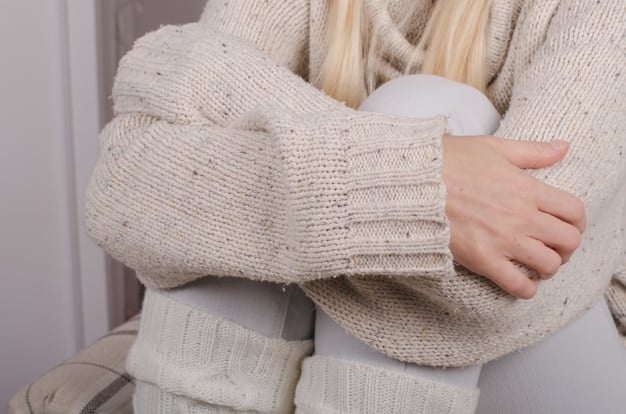Extend Your Wardrobe’s Life: Ultimate Clothes Care Guide

Anúncios
Achieving clothing longevity involves understanding fabric care, employing proper washing and storage techniques, and embracing mindful consumption to maintain garment quality and reduce environmental impact.
In a world increasingly focused on sustainability and mindful consumption, knowing how to care for your clothes: extending the life of your wardrobe has become more than just a chore—it’s an essential skill. Our garments are investments, both financially and emotionally, and their proper maintenance ensures they look better, last longer, and reduce our environmental footprint. This comprehensive guide delves into effective strategies for preserving your favorite pieces, moving beyond simple washing instructions to embrace a holistic approach to wardrobe longevity.
Anúncios
understanding fabric types and their unique needs
Before even thinking about washing or storing, a fundamental understanding of different fabric types is crucial. Each material possesses unique characteristics that dictate its ideal care routine, ensuring its integrity and appearance are maintained over time. Misattributing care methods can lead to shrinking, stretching, fading, or damage, significantly shortening a garment’s lifespan.
Natural fibers, derived from plants or animals, often require a more delicate touch. Cotton, known for its breathability and durability, can withstand regular washing but is prone to shrinking if exposed to high heat. Linen, another plant-based fiber, is highly absorbent and strong but wrinkles easily and should be ironed while damp. Wool, a protein fiber from sheep, is celebrated for its warmth and resilience but needs gentle washing to prevent felting and shrinking. Cashmere, a luxury wool, is even more delicate, demanding hand washing or dry cleaning.
synthetic fibers: strength and versatility
Synthetic fibers, developed from petroleum-based chemicals, offer unique advantages like wrinkle resistance, quick drying, and strength. Polyester is incredibly durable and resistant to stretching and shrinking, making it ideal for activewear and outdoor gear. Nylon is similarly strong and elastic, often used in hosiery and swimwear. Acrylic, designed to mimic wool, is warm and soft but can pill easily and should be washed with care to maintain its texture.
Anúncios
- Polyester: Machine wash cold, tumble dry low.
- Nylon: Hand wash or machine wash cold, air dry.
- Acrylic: Machine wash cold on a gentle cycle, lay flat to dry.
Understanding these fundamental differences empowers you to tailor your care routine, preventing common pitfalls and extending the beautiful life of your garments. Always check the care label—it’s the first and most critical step in decoding your garment’s specific needs, often providing concise symbols and instructions tailored by the manufacturer.
Moving beyond broad categories, some fabrics are blends, combining natural and synthetic fibers to achieve desired properties. For instance, a cotton-polyester blend might offer the comfort of cotton with the wrinkle resistance of polyester. In such cases, the care instructions often lean towards the more delicate fiber in the blend, or a balanced approach that caters to both. Always prioritize the care label as the definitive guide.
the art of mindful laundry: washing and drying techniques
Proper washing and drying techniques are the cornerstones of clothing longevity. It’s not just about getting clothes clean; it’s about doing so in a way that preserves fabric, color, and fit. This section delves into the nuances of laundry practices that go beyond simply tossing everything into the machine.
Starting with preparation, always separate your laundry by color (lights, darks, and whites) to prevent dye transfer. Beyond color, separating by fabric type is equally important. Delicate items like lace or silk should be washed separately or in mesh laundry bags to protect them from agitators and heavier garments. Turning items inside out, especially dark colors or printed garments, can also help preserve their vibrancy and prevent surface wear.
choosing the right detergent and water temperature
The type and amount of detergent you use play a significant role. Opt for mild, enzyme-free detergents for delicate items and wool, as harsh chemicals can damage fibers. Using too much detergent doesn’t make clothes cleaner; it can actually leave residue, dulling colors and attracting dirt. Always follow the detergent’s recommended dosage based on your load size and water hardness.
Water temperature is another critical factor. Cold water is generally best for most laundry, as it’s gentler on fabrics, saves energy, and prevents color fading and shrinking. Hot water is suitable for heavily soiled whites or items needing sanitization, but it can set stains, shrink certain fabrics, and cause colors to bleed. Lukewarm water serves as a good middle ground for moderately soiled colored items.
- Cold water: Best for colors, delicates, and energy saving.
- Warm water: Good for moderately soiled items.
- Hot water: For whites, heavily soiled items, or sanitization (use sparingly).
When it comes to drying, air drying is often the gentlest method. Hanging clothes on a line or laying them flat prevents shrinkage, stretching, and damage from heat. For items that can be machine dried, use the lowest heat setting possible or a tumble dry low/no heat option. Over-drying can weaken fibers, cause shrinkage, and lead to wrinkles that are harder to remove. Removing clothes while slightly damp can also reduce wrinkling and make ironing easier. Understanding these techniques empowers you to perform laundry with precision, extending the life and beauty of your cherished garments.
smart storage solutions: protecting your garments
Beyond cleaning, how you store your clothes profoundly impacts their longevity. Proper storage protects garments from dust, pests, light, and deformation, preserving their shape and fabric integrity. An organized and mindful storage system is an essential component of a well-cared-for wardrobe.
Consider the type of hanger you use. Padded or wooden hangers are ideal for structured items like jackets, coats, and delicate silks, as they help maintain the garment’s shape and prevent stretching or creasing at the shoulders. Wire hangers, while convenient, can distort the shape of clothing over time and are best avoided for anything other than lightweight, low-value items. For pants and skirts, clip hangers prevent creasing and allow garments to hang smoothly.
seasonal storage and garment longevity
Seasonal storage requires special attention. Before packing away winter sweaters or summer dresses, ensure they are thoroughly clean. Storing soiled clothing can attract moths and other pests, and stains can set permanently over time. Use breathable garment bags for items you’re storing for extended periods, especially those made of natural fibers like wool and silk. Avoid plastic dry cleaning bags, as they can trap moisture and cause yellowing or mildew.
- Use breathable garment bags for long-term storage.
- Store delicate items flat to prevent stretching.
- Protect garments from direct sunlight to prevent fading.
Store clothes in a cool, dry, dark place. Humidity can lead to mildew, while direct sunlight can fade colors and weaken fibers. Cedar blocks or lavender sachets can act as natural moth repellents, offering an eco-friendly alternative to chemical mothballs. Regularly airing out your closet or storage area can also help prevent mustiness. By implementing these smart storage solutions, you’re not just decluttering; you’re
actively preserving the quality and extending the life of your wardrobe, making it last for years and seasons to come.
repair and maintenance: giving clothes a second life
The journey of clothing longevity often involves more than just preventive care; it includes proactive repair and maintenance. Rather than discarding items at the first sign of wear, embracing simple mending techniques can significantly extend a garment’s active life, reducing waste and fostering a more sustainable approach to fashion. Learning basic repair skills not only saves money but also instills a greater appreciation for your wardrobe.
Common issues like loose buttons, popped seams, or small tears are easily fixable. Reattaching a button is a fundamental skill that requires only a needle, thread, and a few minutes of your time. Similarly, a small seam separation can be hand-stitched back together, preventing it from unraveling further. For holes or worn areas, especially in knits, darning or patching can discreetly mend the damage while adding unique character to the garment. Websites and local community centers often offer workshops or tutorials for these basic repairs.
stain removal essentials: a targeted approach
Effective stain removal is another crucial aspect of maintenance. The key to successful stain treatment is acting quickly. Different stains require different approaches: oil-based stains benefit from absorbing powders like cornstarch before washing, while protein-based stains (like blood or grass) should be treated with cold water to prevent them from setting. Always test stain removers on an inconspicuous area of the garment first to ensure they don’t damage the fabric or color. Avoid rubbing stains vigorously, as this can spread them or damage fibers.
- Treat stains immediately for best results.
- Research specific stain removal methods for different types of stains.
- Always test stain removers on an inconspicuous area first.
Beyond repairs and stain removal, regular maintenance like de-pilling sweaters with a fabric shaver or lint roller, and using a clothes brush for wool and tweed, can keep garments looking fresh. Proper pressing and steaming can also restore a garment’s crispness and drape after washing, making them ready to wear. By embracing these repair and maintenance practices, you transform from a passive consumer into an active participant in your wardrobe’s care, fostering a deeper connection with your clothes and ensuring they remain cherished pieces for longer.
sustainable habits: a holistic approach to fashion
Extending the life of your wardrobe isn’t just about individual garment care; it’s intricately linked to fostering sustainable habits within a broader, circular fashion economy. Adopting a holistic approach means re-evaluating our consumption patterns, supporting ethical practices, and consciously contributing to a more responsible textile industry. This shift away from fast fashion’s disposable mentality is crucial for both personal finances and planetary health.
Starting with purchasing decisions, prioritize quality over quantity. Investing in well-made garments from durable fabrics ensures they will withstand wear and last longer, reducing the need for constant replacements. Research brands that commit to ethical production practices, fair labor, and transparent supply chains. Shopping secondhand, whether through thrift stores, consignment shops, or online platforms, is another powerful way to embrace sustainability. It gives pre-loved clothes a new life, diverting them from landfills and cutting down on the resources needed for new production.
embracing conscious consumption and circularity
Beyond purchasing, consider the entire lifecycle of a garment. When a piece has reached the end of its wearable life, think beyond the trash bin. Can it be repurposed into cleaning cloths, rags, or creative DIY projects? Many textiles can be recycled, sometimes even into new fibers, though this process is still evolving. Donating wearable clothes to charities or selling them also keeps them in circulation, benefiting others and extending their utility.
- Choose quality over quantity when buying new clothes.
- Support brands with ethical and sustainable production.
- Explore secondhand shopping to give clothes a new life.
Educating yourself about fashion’s environmental and social impact empowers more informed choices. Understanding issues like water consumption in denim production or the pollution caused by synthetic dyes can deepen your commitment to conscious consumption. Participating in clothing swaps or rental services for special occasions offers alternatives to buying new. Ultimately, a holistic approach to clothing care integrates responsible consumption, mindful maintenance, and thoughtful disposal, building a wardrobe that is not only stylish but also sustainable and respectful of our planet’s resources.
By making conscious choices throughout the life of a garment—from purchase to disposal—we contribute to a more sustainable fashion ecosystem. This extends beyond individual actions to collectively supporting brands and initiatives that prioritize environmental and social responsibility. The goal is to move towards a fashion industry that is regenerative, where resources are reused and cycled, minimizing waste and maximizing value. This paradigm shift benefits everyone, from consumers to producers, and most importantly, the planet.
| Key Aspect | Brief Description |
|---|---|
| 📖 Fabric Knowledge | Understand unique care needs for natural vs. synthetic fibers to prevent damage and prolong wear. |
| 🧺 Laundry Techniques | Separate properly, use right detergent/temp, and opt for air drying to preserve fabric and color. |
| 📦 Smart Storage | Use appropriate hangers, store clean, and protect from elements to maintain garment shape and quality. |
| 🧵 Repair & Reuse | Learn basic mending and stain removal; embrace de-pilling to extend garment life and reduce waste. |
Frequently Asked Questions About Clothing Care
The frequency depends on the garment type and how often it’s worn. Outerwear like jackets or jeans can be worn multiple times before washing, while underwear and socks should be washed after each use. Delicates and items worn directly against the skin often require more frequent washing to prevent odors and maintain hygiene.
To prevent shrinking, always check the care label and follow its instructions. Generally, washing in cold water and air drying or tumble drying on a very low heat setting are the most effective methods. High heat, especially in dryers, is the primary culprit for fabric shrinkage, particularly with natural fibers like cotton and wool.
No, fabric softener should not be used on all clothes. It can reduce the absorbency of towels, degrade the elasticity of activewear, and leave residue on certain synthetic fabrics. Always check the care label or material composition beforehand. For most garments, a vinegar rinse can serve as a natural softener without negative side effects.
Not always. “Dry clean only” labels are sometimes more about precaution than strict necessity. Many natural fibers like silk, wool, and linen can be carefully hand-washed at home with gentle detergents. However, structured items like suits or garments with intricate embellishments often genuinely require professional dry cleaning to maintain their shape and integrity.
Pilling, those small balls of fiber that form on the surface of fabrics, can be effectively removed using a fabric shaver or a de-piller. These tools gently cut or lift the pills away without damaging the underlying fabric. A lint roller can help for very light pilling, but a dedicated shaver offers better results for more stubborn instances, refreshing the garment’s appearance.
conclusion: a mindful approach to your wardrobe
The journey to mastering clothing care and extending your wardrobe’s life is a rewarding one, weaving together practical knowledge with a deeper appreciation for your garments. By understanding fabric nuances, adopting mindful washing and drying habits, implementing smart storage solutions, and embracing proactive repair, you transform everyday chores into acts of sustainable stewardship. This holistic approach not only preserves the beauty and utility of your cherished clothes but also reflects a broader commitment to conscious consumption, reducing waste and fostering a more ethical relationship with fashion. Ultimately, a well-cared-for wardrobe is a testament to mindful living, offering both personal satisfaction and a positive impact on the world around us.





